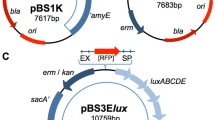Abstract
β-galactosidase encoded by lacZ remains a popular reporter enzyme. Here, we present a convenient tool box to facilitate rapid construction of reporter lacZ fusions. The first tool enables the simple generation of chromosomally encoded reporters within the Escherichia coli lac operon using Red®/ET® recombination. The second tool allows the introduction of lacZ reporter fusions into the chromosome by a single-crossover method. The third tool comprises four pBBR1-based broad-host-range vectors to derive transcriptional and translational lacZ fusions.
Similar content being viewed by others
Literatur
Beckwith J (1963) Restoration of operon activity by suppressors. Biochim Biophys Acta 76:162–164
Wilson CJ, Zhan H, Swint-Kruse L et al. (2007) The lactose repressor system: paradigms for regulation, allosteric behavior and protein folding. Cell Mol Life Sci 64:3–16
Huber RE, Kurz G, Wallenfels K (1976) A quantitation of the factors which affect the hydrolase and transgalactosylase activities of β-galactosidase (E. coli) on lactose. Biochemistry 15:1994–2001
Fried L, Lassak J, Jung K (2012) A comprehensive toolbox for the rapid construction of lacZ fusion reporters. J Microbiol Methods 91:537–543
Heermann R, Zeppenfeld T, Jung K (2008) Simple generation of site-directed point mutations in the Escherichia coli chromosome using Red®/ET® Recombination. Microb Cell Fact 7:14
Lassak J, Henche AL, Binnenkade L et al. (2010) ArcS, the cognate sensor kinase in an atypical Arc system of Shewanella oneidensis MR-1. Appl Environ Microbiol 76:3263–3274
Kolter R, Helinski DR (1978) Construction of plasmid R6K derivatives in vitro: characterization of the R6K replication region. Plasmid 1:571–580
Antoine R, Locht C (1992) Isolation and molecular characterization of a novel broad-host-range plasmid from Bordetella bronchiseptica with sequence similarities to plasmids from gram-positive organisms. Mol Microbiol 6:1785–1799
Kovach ME, Elzer PH, Hill DS et al. (1995) Four new derivatives of the broad-host-range cloning vector pBBR1MCS, carrying different antibiotic-resistance cassettes. Gene 166:175–176
Paradis-Bleau C, Kritikos G, Orlova K et al. (2014) A genome-wide screen for bacterial envelope biogenesis mutants identifies a novel factor involved in cell wall precursor metabolism. PLoS Genet 10:e1004056
Zhang YZ, Naleway JJ, Larison KD et al. (1991) Detecting lacZ gene expression in living cells with new lipophilic, fluorogenic β-galactosidase substrates. FASEB J 5:3108–3113
Jonuscheit M, Martusewitsch E, Stedman KM et al. (2003) A reporter gene system for the hyperthermophilic archaeon Sulfolobus solfataricus based on a selectable and integrative shuttle vector. Mol Microbiol 48:1241–1252
Author information
Authors and Affiliations
Corresponding author
Additional information
Jürgen Lassak Biologiestudium an der Universität Tübingen. 2007–2010 Promotion am Max-Planck-Institut für Terrestrische Mikrobiologie in Marburg. Seit 2010 wissenschaftlicher Mit arbeiter in der Gruppe von Prof. Dr. K. Jung an der LMU München als Postdoktorand und seit 2013 als Akademischer Rat.
Luitpold Fried Biologiestudium an der LMU München, dort 2008–2013 Doktorand und Postdoktorand in der Gruppe von Prof. Dr. K. Jung. Seit 2013 technischer Leiter der Dust Bio-Solutions GmbH in München.
Kirsten Jung Biochemiestudium und Promotion an der Universität Leipzig. 1992–1994 Postdoktorandenaufenthalt am Howard Hughes Medical Institute, University of California, Los Angeles, USA. 1994–2002 Wissenschaftliche Mitarbeiterin und Heisenbergstipendiatin an der Universität Osnabrück. 2002–2004 Professorin für Mikrobiologie an der TU Darmstadt. Seit 2004 Lehrstuhl inhaberin für Mikrobiologie an der LMU München.
Rights and permissions
About this article
Cite this article
Lassak, J., Fried, L. & Jung, K. Angestaubt, aber nicht eingerostet — der Bioreporter LacZ. Biospektrum 20, 510–513 (2014). https://doi.org/10.1007/s12268-014-0473-7
Published:
Issue Date:
DOI: https://doi.org/10.1007/s12268-014-0473-7




